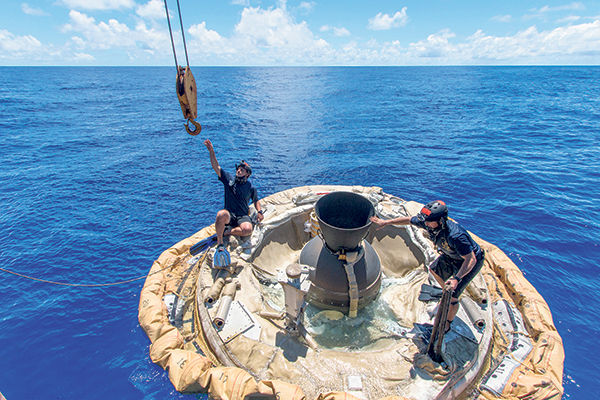NASA to return to PMRF next summer
LIHUE — Following a successful launch in June, NASA will return to Kauai next summer for additional experimental test flights of its saucer-shaped Low-Density Supersonic Decelerator.
The space agency is testing technologies, including a decelerator and a supersonic parachute, that will allow it to land heavier payloads, including people, on the red planet.
“We’re going to want to put two-story condominiums on the surface of Mars, and that gets really big and really hard,” said project manager Mark Adler of NASA’s Jet Propulsion Laboratory. “So really, this is like the second step of a 12-step program to get to the point where we can put very large things on Mars.”
On June 28, NASA successfully launched the LDSD from Kauai’s Pacific Missile Range Facility. Over the last six weeks, scientists have been analyzing data from that flight and shared their findings, including a number of high-definition videos, during a press conference Friday in Pasadena, California.
“If a picture is worth 1,000 words, then a video is worth about a million,” Adler said.
One of the videos shows the vehicle’s parachute, the largest supersonic parachute ever built, ripping apart as it is deployed from the LDSD.
“We see the parachute beginning to inflate … but very early on it begins developing tears, and once it has those tears, the parachute structure just won’t hold its geometry very well,” LDSD project manager Ian Clark said.
Despite the malfunction, NASA says the test was a success, and it has already learned a lot from reviewing the videos.
“We’ve learned, for one, that we have more to learn about supersonic parachute inflation,” Clark said. “The idea of taking 200 pounds of kevlar and nylon and deploying it at 2,500 mph — 200 pounds that, inflated, would be the size of a small warehouse — is certainly a challenging endeavor.”
Overall, Adler described it as a great flight; one that proved the LDSD can do what it needs to do.
“We have two flights scheduled for next summer in the June, July, August time frame,” he said. “We’re going to again be flying two more SIADs and two parachutes — redesigned, rebuilt parachutes — based on what we learned from this first flight.”
The goal of the experimental flight test was to determine if the balloon-
launched, rocket-powered, saucer-shaped, design could reach the altitudes and airspeeds needed to test two new breakthrough technologies destined for future Mars missions, according to a release.
Clark said the vehicle did an “amazing job” of reaching the speeds and altitudes that the technologies will face on Mars.
It took about two hours for a 34-million cubic foot helium balloon to reach 120,000 feet. Once at that altitude, the balloon dropped the rocket propelled LDSD, which soared from 24 to 32 miles above the Earth and traveled at four times the speed of sound.
The first of the vehicle’s two landing technologies, a doughnut-shaped tube called the Supersonic Inflatable Aerodynamic Decelerator (SIAD), deployed as expected, slowing the vehicle to Mach 2.5, according to NASA.
The agency says it is in the process of altering and strengthening the supersonic parachute for its upcoming tests next year.
“As far as I am concerned, whenever you get to ride shotgun on a rocket-powered flying saucer, it is a good day,” Clark said in a release. “We hope the video will show everyone how beautiful and awesome the test was, and to just to give folks an insight into what experimental flight test is all about.”
High resolution images and video clips from the June test flight from PMRF are available at http://go/usa/gov/N5zm.
•••
Chris D’Angelo, environment writer, can be reached at 245-0441 or cdangelo@thegardenisland.com.

